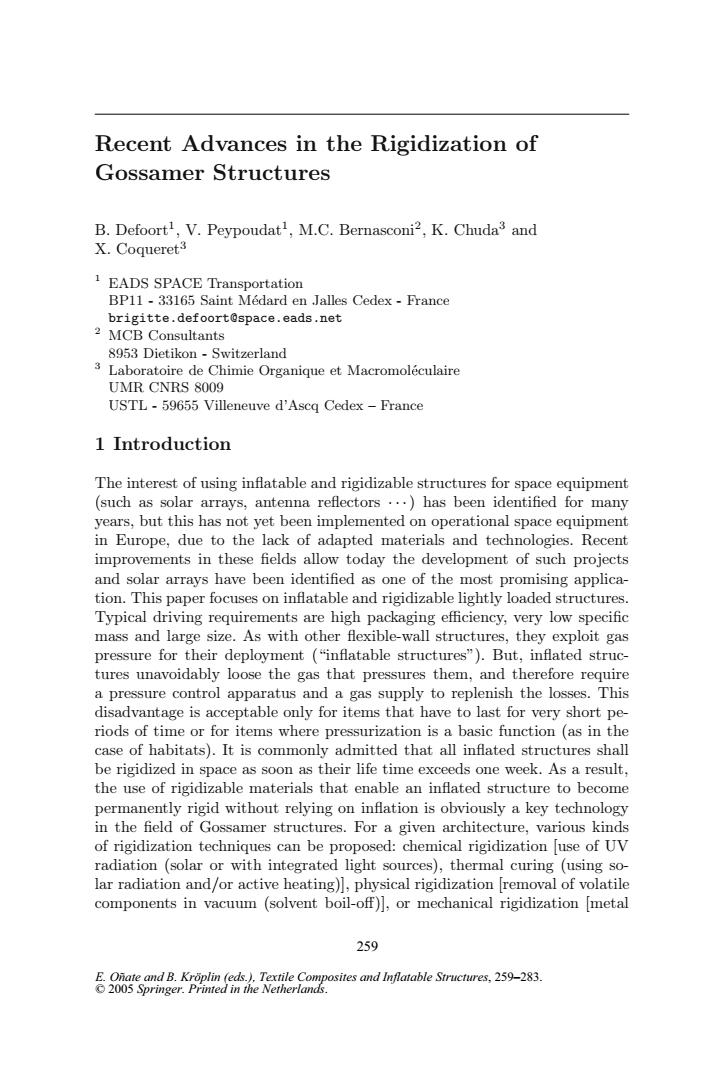正在加载图片...

Recent Advances in the Rigidization of Gossamer Structures B.Defoortl,V.Peypoudatl,M.C.Bernasconi2,K.Chuda3 and X.Coqueret3 1 EADS SPACE Transportation BP11-33165 Saint Medard en Jalles Cedex-France brigitte.defoort@space.eads.net 2 MCB Consultants 8953 Dietikon Switzerland 3 Laboratoire de Chimie Organique et Macromoleculaire UMR CNRS 8009 USTL -59655 Villeneuve d'Ascq Cedex-France 1 Introduction The interest of using inflatable and rigidizable structures for space equipment (such as solar arrays,antenna reflectors ...)has been identified for many years,but this has not yet been implemented on operational space equipment in Europe,due to the lack of adapted materials and technologies.Recent improvements in these fields allow today the development of such projects and solar arrays have been identified as one of the most promising applica- tion.This paper focuses on inflatable and rigidizable lightly loaded structures. Typical driving requirements are high packaging efficiency,very low specific mass and large size.As with other flexible-wall structures,they exploit gas pressure for their deployment ("inflatable structures").But,inflated struc- tures unavoidably loose the gas that pressures them,and therefore require a pressure control apparatus and a gas supply to replenish the losses.This disadvantage is acceptable only for items that have to last for very short pe- riods of time or for items where pressurization is a basic function (as in the case of habitats).It is commonly admitted that all inflated structures shall be rigidized in space as soon as their life time exceeds one week.As a result, the use of rigidizable materials that enable an inflated structure to become permanently rigid without relying on inflation is obviously a key technology in the field of Gossamer structures.For a given architecture,various kinds of rigidization techniques can be proposed:chemical rigidization [use of UV radiation (solar or with integrated light sources),thermal curing (using so- lar radiation and/or active heating),physical rigidization removal of volatile components in vacuum (solvent boil-off)],or mechanical rigidization [metal 259 E.Onate and B.Kroplin (eds.).Textile Composites and Inflatable Structures,259-283. 2005 Springer.Printed in the Netherlands.Recent Advances in the Rigidization of Gossamer Structures B. Defoort1, V. Peypoudat1, M.C. Bernasconi2, K. Chuda3 and X. Coqueret3 1 EADS SPACE Transportation BP11 - 33165 Saint M´edard en Jalles Cedex - France brigitte.defoort@space.eads.net 2 MCB Consultants 8953 Dietikon - Switzerland 3 Laboratoire de Chimie Organique et Macromol´eculaire UMR CNRS 8009 USTL - 59655 Villeneuve d’Ascq Cedex – France 1 Introduction The interest of using inflatable and rigidizable structures for space equipment (such as solar arrays, antenna reflectors · · ·) has been identified for many years, but this has not yet been implemented on operational space equipment in Europe, due to the lack of adapted materials and technologies. Recent improvements in these fields allow today the development of such projects and solar arrays have been identified as one of the most promising application. This paper focuses on inflatable and rigidizable lightly loaded structures. Typical driving requirements are high packaging efficiency, very low specific mass and large size. As with other flexible-wall structures, they exploit gas pressure for their deployment (“inflatable structures”). But, inflated structures unavoidably loose the gas that pressures them, and therefore require a pressure control apparatus and a gas supply to replenish the losses. This disadvantage is acceptable only for items that have to last for very short periods of time or for items where pressurization is a basic function (as in the case of habitats). It is commonly admitted that all inflated structures shall be rigidized in space as soon as their life time exceeds one week. As a result, the use of rigidizable materials that enable an inflated structure to become permanently rigid without relying on inflation is obviously a key technology in the field of Gossamer structures. For a given architecture, various kinds of rigidization techniques can be proposed: chemical rigidization [use of UV radiation (solar or with integrated light sources), thermal curing (using solar radiation and/or active heating)], physical rigidization [removal of volatile components in vacuum (solvent boil-off)], or mechanical rigidization [metal 259 E. Oñate and B. Kröplin (eds.), Textile Composites and Inflatable Structures, 259–283. © 2005 Springer. Printed in the Netherlands